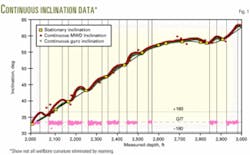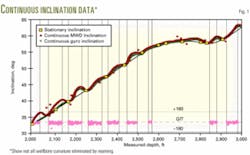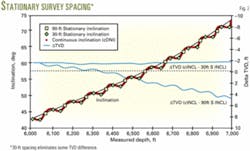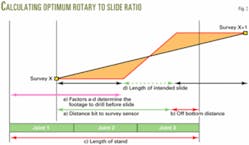Changes in directional drilling and surveying practices could lead to a reduction in positional errors arising from nonconstant wellbore curvature.
Part 1 of this series (OGJ, Oct. 27, 2003, p. 51) revealed where positional inaccuracies occur in horizontal wells and how frequently they happen when drilling with a conventional, steerable, positive-displacement motor (PDM) system.
Part 2 (OGJ, Nov. 3, 2003, p. 50) further illustrated positional issues using PDMs and then discussed rotary steerable systems and the impact of lithology on accurate well placement.
This final installment offers recommendations and techniques that can minimize the problem.
While drilling, postdrilling surveys
Many have believed that the nonconstant curvature caused by slide and rotate drilling with PDMs is reamed out by pipe rotation and tripping actions as the well progresses. Some have thought that wellbore tortuosity and positional difference were thereby eliminated, resulting in a smooth borehole. This assumption was long unquestioned until continuous surveys made while drilling could be compared with continuous gyro surveys taken after drilling each section.
Fig. 1 shows stationary, continuous measurement-while-drilling (MWD), and continuous gyro inclination survey data from a 1,000 ft, 121/4-in. diameter section of a North Sea well. Angle was built during the slide sections and held during rotation, as previously demonstrated in Part 1.
Gyro data taken after drilling the 121/4-in. section show that some reduction in the curve rate tortuosity did occur as drilling progressed; however, a majority of the tortuosity remained.
Positional errors, sensor accuracy
The positional difference found when computing wellbore location from directional surveys with nonconstant curvature is not the same as the positional accuracy calculated with accepted error models.
Be careful not to confuse the two; such a comparison is misleading. One is an accuracy based on sensor characteristics, while the other is an effect based on sensor use. Both of these attributes of survey analysis are real and independent of each other.
There are distinct and separate methods for reducing the effects of both sensor accuracy and nonconstant curvature. The survey accuracy issue affects every directional well. The nonconstant curvature issue affects wells in which curvature changes significantly, and survey spacing is greater than 45 ft. The population of wells with this positional problem is clearly a subset of wells with sensor-accuracy issues.
Back track or move forward?
The problem of positional difference resulting from nonconstant curvature in wellbores has gradually crept into directional drilling practices. Several solutions are available based on modifying directional drilling methods, survey calculations, and procedures in drilling measurements.
The obvious solution to this problem would be to go back to taking surveys every 30 ft. Analyses made during the studies cited in Part 2 indicate that positional differences would be reduced by more than 90% by returning to 30-ft surveys.
Fig. 2 shows how using 30-ft stationary surveys reduces the TVD difference between continuous and stationary inclination measurements.
Since there is yet no methodology for combining stationary and continuous survey data and maintaining manageable sensor error models, returning to 30-ft survey stations is the simplest way to minimize this problem consistently. It would not require the introduction of new procedures to the directional drilling industry.
It would, however, greatly reduce a popular feature of top-drive drilling by interrupting the drilling of 90-ft hole sections.
To return to 30-ft surveying would add time and, therefore, operational cost. One estimate showed that adding back the two surveys per stand would require another $50,000/offshore well on average, more in deepwater situations. Yet why return to this older, less-efficient procedure when continuous survey data exist? Several alternatives exist.
A balanced sliding approach
A closer look at how positional differences develop shows that the problem occurs as a result of where in the drilling sequence the stationary surveys are taken relative to where within each stand of pipe the directional driller chooses to slide. Two things could be changed: the surveys could be taken at different depths, and the depths of the slide sections could be changed.
Currently, surveys are taken after drilling a stand and as close to the bottom of the hole as possible without increasing the risk of sticking the pipe. This procedure is nearly universal in directional drilling. Placement of the slide section for each stand of pipe is more discretionary, however.
The directional driller typically decides the footage needed for each slide section to achieve trajectory objectives. The slide is usually placed in the first part of the stand being drilled, taking hole cleaning procedures and sticking avoidance into consideration. Taking positional issues into consideration at this point should not be a problem.
The location of a slide section within the drilling of a stand of pipe can be balanced to minimize the effect of noncontinuous curvature on wellbore position. This would not eliminate the contrasting curvatures found with PDM drilling, but it would alter the locations of these curvatures so that they cancel out one another before positional differences can accumulate.
Half of the difference between continuous and stationary survey data would be above the line drawn between stationary surveys, and half would be below. The net difference would be zero.
Factors that must be considered to balance a slide section include: the distance from the bit to the MWD survey sensor, the standard stationary surveying distance off-bottom, the stand length, and the slide section length. Fig. 3 shows how these factors come together to produce the desired result.
This is an easy computation that the directional driller can make for each stand of pipe to determine a recommended footage to drill in rotary mode in the stand before initiating sliding. Should hole cleaning, stability, or sticking problems override this recommendation, the stationary survey location can be changed to balance the slide.
Operational procedures for implementing this solution currently are under investigation, including real-time analysis of continuous and stationary survey data to minimize the delta TVD difference between the two survey sets.
Other alternatives
It is feasible to develop a new method for calculating position from survey data that account for nonconstant curvature. Several approaches are possible, based on previous knowledge of the curve rates for slide and rotary directional drilling.
The location and tool face for slide sections, commonly found in a directional driller's slide sheets, could be used in this type of survey calculation. This may be the best solution for historical data that do not include continuous survey measurements, but do include records of directional tactical operations in well reports.
Simulated surveys could be added to the stationary survey data based on continuous survey results. These simulated surveys would have the effect of altering the positional calculation in the stationary surveys so that it matches the position calculated from the continuous surveys alone.
This approach achieves the desired result, but it has problems. One is that there are many ways to make the calculation. Another is the number of simulated surveys to be used between the stationary surveys.
The availability of continuous surveying today will allow these solutions to be further developed and tested. Using these data in real-time to compare and contrast survey results would significantly help to improve the placement of directional wells.
Findings
Positional errors can result from nonconstant curvature between stationary surveys taken at spacings of 90 ft or greater. These errors have crept into directional drilling with the wide use of PDM steerable motors and top drive systems. Analysis of continuous MWD and gyro survey data has quantified two facts: survey frequency matters, and traditionally placed, 90-ft surveys are inadequate when TVD position is important.
In fact, up to 60% of horizontal wells may have positional errors because of current directional drilling and surveying practices.
Positional errors can result from the relationship between the location of stationary surveys and the nature of slide and rotate directional drilling patterns. Balancing the location of the slide sections is a nonintrusive, low-cost method that greatly reduces potential errors.
Rotary steerable systems produce wellbores with a more constant curvature. Thus, potential positional errors are greatly reduced. Care must be taken to obtain survey data at points where the settings are changed.
Monitoring positional differences between continuous and stationary measurements in real-time and taking additional stationary surveys when necessary effectively minimize the four primary sources of TVD positional errors. New methods of calculating the position of a wellbore from stationary survey data are possible and numerous.
Long-term, accurate, continuous survey data, supported by a proven data error model, can be combined with normal stationary surveys taken every stand to provide unprecedented wellbore positional accuracy. At the same time, real-time surveys can be used for definitive survey purposes.
Acknowledgments
The authors thank Stan Franklin and Mike Sullivan, ChevronTexaco Inc., and Stan Ingham, Schlumberger, for bringing this issue to our attention and providing many of the data sets. We also thank Connor O'Kelly, Schlumberger, John Potter and John Lofton, ChevronTexaco, for data analysis assistance and project recommendations.




